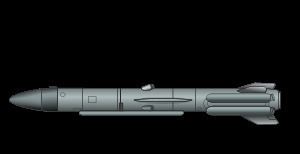Type Anti-shipping missile In service 1968-1995 Weight 7,700 lb (3,500 kg) | Length 23.0 ft (7.0 m) | |
 | ||
Manufacturer NPO Mashinostroyeniya (Chelomei) | ||
The P-70 Ametist (NATO reporting name SS-N-7 Starbright, GRAU designation 4K66; Russian: П-70 «Аметист» 'Amethyst') was an anti-ship missile carried by Soviet and Indian Charlie-I submarines, as well as the Soviet Papa class submarine. It was soon succeeded by the P-120 Malakhit (SS-N-9 'Siren').
Contents
Development
The P-5 Pyatyorka (SS-N-3 Shaddock) missile required the Echo-class submarines carrying them to spend 30 minutes or more on the surface when firing. This made submarines very vulnerable to enemy attack, so in the 1960s the Soviets started work on a new missile that could be fired whilst submerged, and a submarine to carry it. These became the P-120 Malakhit (SS-N-9 'Siren') and Charlie-class submarine.
However, problems with the engines of the P-120 Malakhit forced the Soviets to design a sub-launched missile based on the P-15M Termit (SS-N-2C 'Styx') as a stopgap measure for the first batch of Charlie submarines. This became the P-20L, later renamed the P-70 Ametist.
Design
The P-15M was fitted with an L band active radar homing sensor and a new radar altimeter both developed for the 'Siren', but there was no room for a datalink in the smaller 'Styx'. Folding wings were added to reduce the size of the missile, and the missile can be launched at a maximum depth of 30 m (98 ft).
The short range of the P-70 meant it did not need mid-course updates from a radar on the submarine, so it could be fired submerged. This more than made up for its lack of range compared to the 'Shaddock'.
Operational history
The P-70 went into service with the Soviet Navy on the first Charlie I, on June 3, 1968. About 200 were produced.
India leased the Chakra, a Soviet Charlie I submarine from January 1988 to 1992, to gain experience of operating a nuclear submarine.
